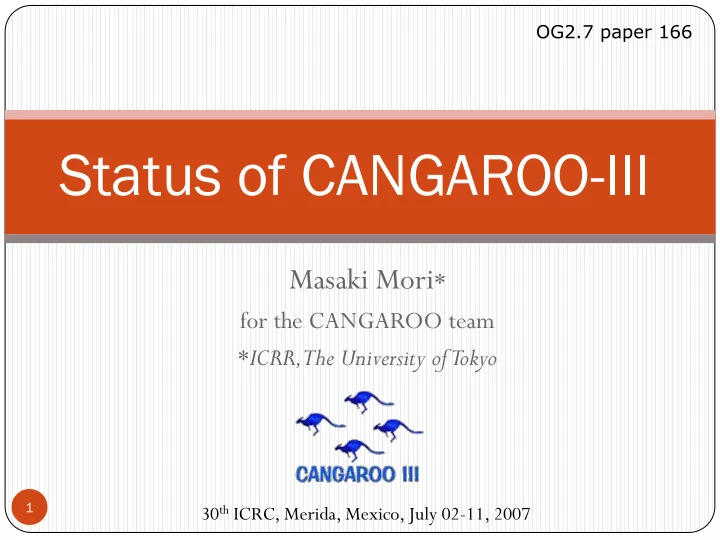

OG2.7 paper 166 Status of CANGAROO-III Masaki Mori * for the CANGAROO team * ICRR, The University of Tokyo 30 th ICRC, Merida, Mexico, July 02-11, 2007 1
CANGAROO team University of Adelaide Kitasato University Australian National University Australia Telescope National Facility Ibaraki University Tokai University Ibaraki Prefectural University ICRR, University of Tokyo Konan University Yamagata University Kyoto University Yamanashi Gakuin University STE Lab, Nagoya University Hiroshima University National Astronomical Observatory of Japan 2
CANGAROO-III: since 2004 March T2 T4 T3 T1 3
Enomoto et al., Proc. ICRC 2003 Basic specifications of telescopes Location: T2 31 06 ’ S, 136 47 ’ E 160m a.s.l. Telescope: 114 80cm FRP mirrors (57m 2 , Al surface) 8m focal length Alt-azimuth mount Camera: T1: 552ch (2.7 FOV) T2,T3,T4: 427ch (4 FOV) Electronics: 4 TDC+ADC
History of CANGAROO-III 1999 2000 2006 2007 2001 2002 2003 2004 2005 1 6 3 3 1112 7 3 12 8 T1 Stereo observation Global trigger system Maintenance T2 T3 T4 : Construction : Observation : Observation start : Tuning : Expansion to 10m 5
R.Enomoto et al., ApJ 638, 397 (2006) Gamma/hadron separation Square cut Limit image moments (width, length) in gamma-ray domains Ex. “ Supercut ” (Whipple group) Likelihood ratio Probability density functions for image moment distributions Gamma-rays: Monte Carlo, hadrons: background (off-source) data Cut by certain Likelihood ratio L Prob( )/[Prob( )+Prob(bkgd)] Fisher discriminant Now standard in CANGAROO-III F linear combination of image moments, with coefficients are uniquely determined by matrix inversion to maximize gamma/background separation Free from selection bias 6
R.Enomoto et al., ApJ 638, 397 (2006) Vela pulsar/nebula • Pulsar pointing (2004 Jan/Feb) Pulsar position • Stereo (T2 & T3 wobble), 1,311 min. • Fisher discriminant Vela X nebula H.E.S.S., AA 448, L43 (2006) 2 from Vela X center 7
R.Enomoto et al., ApJ 638, 397 (2006) Vela X nebula: spectrum 2 <0.6 deg 2 Excess 561 114 H.E.S.S.: Aharonian et al., AA 448, L43 (2006) E -1.45 exp(- E /13.8TeV) 8
R. Enomoto et al, ApJ 652, 1268 (2006) SNR RX J0852.0-4622 • Distance ~1 kpc (NANTEN: Moriguchi et al. ApJ 2005 ) • Stereo (T2 & T3 &T4 wobble) • 1,129 min. ON, 1,081 min OFF (2005 Jan/Feb) • Independent analysis (ICRR, Kyoto) Excess event map Fisher discriminant 9 2 from SNR center
R. Enomoto et al, ApJ 652, 1268 (2006) SNR RX J0852.0-4622: spectrum Comparison with C-II 10
Erratum: C. Itoh et al, A&A 462, 67 (2007) Starburst galaxy NGC253 3-fold, 2004 Oct, 1179min (ON), 753min (OFF) C-III (extended) C-III (point) HESS (extended) HESS (point) 11
Y. Sakamoto et al., K. Nishijima et al., in this conference Flare of Blazar PKS 2155-304 Nearby high-frequency BL Lac (z=0.117) TeV flare report by H.E.S.S. in July-Aug 2006 (ATel#867) 1,053 min (wobble), 3-fold [8 hour difference in Time-zone!] Analyzed by independent teams (ICRR, Tokai, Kyoto) Jul.28 Aug.17-25 av. 6.8 excess 12
Kabuki et al., ApJ (in press, Oct. 2007) / arXiv:0706.0367 [astro-ph] Cen A and Cen (1) Significance map CenA • Radio galaxy, Fanaroff-Riley type I • “Misaligned” BL Lac (~ 60 o ) • Distance 3.5 Mpc (z=0.00183) • Observations: Cen A 639min (ON), 587min (OFF) Cen • Old, heavy globular cluster • Many millisecond pulsars • Distance 4.9 kpc • Observations: 601min (ON), 429min (OFF) Cen Solid: 4850MHz radio (inner lobes and middle lobe ) 13 Dotted: 408MHz radio (outer lobes)
Kabuki et al., ApJ (in press, Oct. 2007) / arXiv:0706.0367 [astro-ph] Cen A and Cen (2) Upper limits of the CDM density SED for the jet region of CenA Cen Bai&Lee 2001 CANGAROO-III HESS Dotted: IC with 10 54 erg, 100 TeV cutoff CDM density <100M pc -3 : less than its gravitational mass! 14
Summary of TeV source status claimed by CANGAROO compared with H.E.S.S results 15
More detections are coming! MSH15-52 HESS J1804-216 HESS J1303-631 Pulsar wind nebula UnID UnID See: Kushida et al., in this See: Nakamori et al., in See: Higashi et al., in this conference this conference conference Ex. Clusters of galaxies: See Kiuchi et al., And upper limits as well… 16 in this conference
Summary CANGAROO-III atmospheric Cherenkov telescope system is observing sub-TeV gamma-rays since 2004 March in stereoscopic mode. Observation of Vela pulsar showed no gamma-ray signal, but there is a hint of signal in the Vela X nebula. SNR RX J0852.0-4622 was detected as an extended source, and the morphology seems to follow the X-ray emission profile. Starburst galaxy NGC 253 was observed with CANGAROO-III but the signal reported by CANGAROO-II was not confirmed. A flaring activity of a blazar PKS 2155-304 was detected in July-August 2006 showing rapid time variation. Radio galaxy Cen A nor globular cluster Cen were not detected. Conflicts with H.E.S.S. results are mostly resolved. Analysis of stereo observations are now established, and application to other sources are underway. 17
Recommend
More recommend